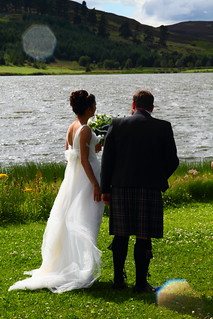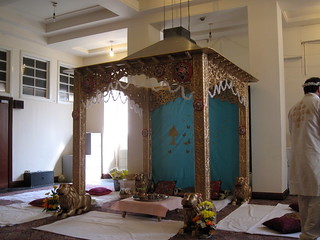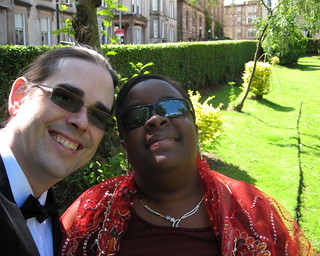
This weekend's word is actually a phrase - Cultural Appropriation.
I've blogged a bit about KidLitCon over the last week, and talked about how last weekend, Charlotte Taylor, our program director, came up with a great way to keep us thoughtful during those brief moments when people were at loose ends. She started a notepad conversation which was ongoing throughout the weekend, and one of the things on the pad was the somewhat plaintive question about how to judge cultural appropriation in fantasy.
And the follow-up question someone else asked was even more direct: "Is using elements of another culture or lots of cultures always a bad thing? When does it become cultural appropriation?"
Both questions are huge and complex, and in the name of not choking on this, let's take it in small bites:
Q: What, first, IS cultural appropriation exactly?
A: By the book (in this case, my sociology book), Cultural appropriation is the taking of pieces of a minority culture by a culture in the majority, which commodifies, invalidates, homogenizes, romanticizes, or otherwise misrepresents the culture in the minority (emphasis mine).
I tried to define it with more words and fewer sociological terms... and I fell short on a slip of paper teetering on a lightweight easel with a purple marker in my hand, between meetings. This question - and that answer - needs a lot, a lot, a LOT more time and space and brain put into it (and a keyboard, thanks), to understand what it means and how to apply it to our writing and to our lives. And, before I touch on what it means to story - to my understanding, anyway, fully knowing that YOUR understanding might be different - I'm going to start somewhere else... I'm going to start with clothes.
(Two reasons for that: one, because Halloween, and WOW, let's just rename it Cultural Appropriation Night RIGHT NOW, and save the hassle, and two, because this is where it touches on my life, and where I can pull a quick and dirty illustration.)
When we lived in Scotland, I had myriad South Asian acquaintances, and a few friends. We patronized the shop of a South Asian importer who frequently went back to Mumbai and elsewhere to load up with items for resale in his spiffy little shop. Glasgow in the wintertime is cold, wet, dreich and dull and I was longing for life and sunshine. Going into his shop was like a little visit to a world nearly as bright as California. I spent a shocking amount of money there - and when we were invited to a wedding at a Hindu temple, I was thrilled to bits to wear culturally appropriate gear! In a temple! I wore my own dress, but wrapped saree fabric around my shoulders and wore a jewelry set from India. Tech Boy wore a boring old tux, because... well, cultural appropriation is a bit different for him. (More on that later.*)

Bride and Groom at their first wedding - in lovely but familiar modern Scottish wedding garb.

A tiny piece of Groom at the Hindu wedding - I don't have pictures not showing their faces, and they didn't ask to be featured on the blog, so...
As I put on the clothes for the wedding, wrapping the saree fabric around myself, I wondered silently, Am I appropriating South Asian culture? I took a moment to seriously think about it, because I do care about this kind of thing. I concluded: I wore unique clothing to support our friend's South Asian heritage and recognize her support of her grandparents' traditions and faith (which was why she was having a second Hindu wedding when she's fairly ambivalent about cultural things in general and her family's traditional faith in specific). I spoke to South Asian people and asked what would be worn to a wedding, and bought, from people of that culture, an appropriately celebratory purchase with the understanding that it was made specifically for being worn to a celebration. I went out of my way to know what I was doing and why, and was proud to wear my finery and be appreciated, and in turn appreciate the finery of the South Asian folk in attendance. I wore it in the correct context, for reasons I understood, and not to exoticize or make a display of myself. I felt I could say that I was not appropriating, but appreciating.
You may disagree, and feel I should not have worn what I did, but I did so deliberately. I remember being at the first wedding, the Scottish wedding, and seeing a.) people in kilts who were not Scottish, and b.) family members in South Asian wedding outfits who were stared at by other guests. I wish people hadn't stared like they'd never seen a saree before - I mean, come on. We all, in our own ways, needed to remember that we were there to support the combining of the two people and cultures represented. We were invited to the celebration, and that day we celebrated individuals AND their cultures.
This does not mean that I would EVER wear a saree for Halloween. Why? Oh, let me count the reasons: A.) Because India is a country, not a costume. B.) because Indian or South Asian-ness is not something for sale. C.) because India and its many language groups and people are alive and well; they're not some romantic and long-lost thing like unicorns that you need to bring back in costume form, or they'll be forgotten and lost in the mists of time. D.) because a girl wearing a bindi in public school might be looked at strangely or treated differently, and if you, a member of the dominant culture, in the same bindi would be thought of as cool it's NOT because you wear it better. D.) because taking items of meaning, like bindis or henna and applying them willy-nilly to your life, because you think they're cute or on-trend is NOT CUTE AT ALL. It can be deeply disrespectful of something you didn't even attempt to understand. E.) because not everyone in India wears the same thing at the same time for the same reasons. Also, keep in mind: not all South Asians share the same faith, or speak the same languages. (Imagine saying in a pub that England, Ireland, Wales and Scotland are all the same. Yeah, you can say that, but you'd better DUCK. They've got dart boards in pubs, and most are fairly handy with the darts.)
Short answer? Find a way to appreciate and celebrate not homogenize or steal bits and pieces of another culture. It is not there to decorate or embellish you.
We're clear now on one small portion of cultural appropriation, at least, right?
When it comes to fantasy fiction, there are many settings and characters who are amazing, and we often find that the writers took their backgrounds from already existing cultures. The great and bow-down-to-able Tamora Pierce uses tons of cultural details in her work. When she spoke in 2007 at SCBWI's Summer Session, she told listeners that she uses the maps from National Geographics and encyclopedias and spreads them out and examines land masses and rivers, to find a place to begin. She uses children's research books as her source books, and finds in them simplified accounts of the ancient history of various places - and inserts it into the story. She uses cookbooks, old song books, topographical maps, baby name and language phrase books to help her get a sense of a place, its language, and its people. She stockpiles fashion books to find out the sumptuary laws of various countries during various times, and buys Vogue's Spring Edition to create casting files of people with difference faces - all of which are well lit and detailed. She does all of these things because human beings thrive on detail. Detail enriches a story, and specific cultural detail enlivens a text.
This sounds like a lot of specific, careful work, this way of including cultural detail. This sounds deliberate, like it shows specifics that summarizing a culture by saying everyone was "almond-eyed" or had caramel-colored skin or whatnot isn't doing. THIS is, to my mind, the first step in how we judge when made-up cultures in fantasy are cultural appropriation - you'll know those books by seeing how little work the author actually did to use their creativity and recreate a place using historical detail as guidelines, rather than a springboard from which to reiterate pervasive cultural stereotypes and move on.
I don't want to move from clothing too deeply into literature just yet, but let me just begin dissecting the books we read and write with an easy story to pull apart in film -- Avatar.
Many people struggled to understand why Avatar was offensive to so many. It did not occur to them how ridiculous a story is told of an exceptional guy of the dominant culture basically good-guying his way into this closed society of blue people, then becoming the best of them, and, because they needed him, and could not possibly have helped themselves, eventually saving them all. The word "marginalize" means to make someone or something unimportant, and peripheral. Not only does this pervasive and long-lived narrative match stories told by members of the dominant culture since the 18th century, elevating themselves and emphasizing how lowly, useless, helpless and dorky the Native cultures are, this type of narrative carries forward the stereotypes that indigenous Americans still have to face today. That's a serious MISuse of a made-up culture in fantasy, and a clear example of marginalizing, as it makes the blue people, who kind of stand in for "natives" everywhere, not the main characters in their own story.

If you read a novel where a fantasy people need an Earthling of the dominant culture to intercede for them because they are unaware of the gold mine of, well, gold or gems or whatever resource Earth would take right off their hands, or if they need this dominant culture Earthling to become their chief because he's better at being an alien than they are, or if these fantasy people are mystical "primitives" -- really look hard at the book you're reading - or writing - and ask yourself if the little bits and pieces of the culture you're taking are yours to use in this way.
This was still a big chunk of thought, so that's enough for now! Tune in next time as I ramble further on exoticism, respect, and reading fantasy from OTHER cultures, and the fun to be had there.
(* Cultural appropriation for a person of the dominant culture, as Tech Boy is, is... well, almost more egregious. During the Raj, the time of British rule in India, which was from around 1858-1947, lots of white-skinned Britons donned South Asian clothing, emigrated to India, started sucking on opium pipes and wearing curly-toed slippers and "went native..." and yet still managed to close their society to the people of India, despite using native servants - and prostitutes - still judged and cut off those people who intermarried with South Asians, and whose children were mixed, and basically used and abused and behaved like they were morally, ethnically, ethically and otherwise in all ways superior to the people in whose land they lived. Does this mean that no white-skinned person should don South Asian clothing? No - but the run of history shows Westerners having a history of imperialism, colonialism and a lot of other hateful -isms [not the least of which is RACISM] that make it doubly problematic for a person of the dominant culture to casually assume elements of an Eastern culture. At least, that's our opinion here - your opinion may, of course, vary.
My opinion is that Tech Boy just looks cute in a tux, and should wear one as often as possible. Preferably when taking me fancy places. ☺)
[Cross-Posted at fiction, instead of lies]


No comments:
Post a Comment